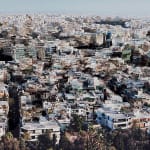Michel Lamoller German, 1984
Acity 5, 2017
Three-dimensional photographic work, consisting of cut archival pigment print
Framed 150 x 75 x 20 cm
Unique piece
MIL 001
Further images
Born in 1984, Michel Lamoller is a native of Germany’s Black Forest region. After an internship at Magnum Photos in New York he studied film, photography and sculpture at the...
Born in 1984, Michel Lamoller is a native of Germany’s Black Forest region. After an internship at Magnum Photos in New York he studied film, photography and sculpture at the Academy of Fine Arts Hamburg and joined the Master class of Professor Matt Mullican.
His work has been presented internationally in numerous exhibitions, i.e. Frieder Burda Museum|Salon Berlin (DE), Museum Benaki Athens (GR), Direktorenhaus Museum Berlin (DE), Art Museum Lishui (CN), Kunstquartier Bethanien, Berlin (DE), Reeperbahnfestival Hamburg (DE), Affenfaust Galerie Hamburg (DE), Nitra Gallery Athens (GR), Sijac Gallery Seoul (KR), London Art Fair (UK), Art International Istanbul (TR).
Within his art, Lamoller uses photography as a material to create multi-layered sculptures which meander between object and image. By alienating the original use of photography, he expands the boundaries of the image – going back to the basics of aesthetic experience. In doing so he continues referring to photography's tradition of documenting reality – just that his unique artistic process doesn’t create an image of reality but transforms images into three dimensional, real-world objects.
His work has been presented internationally in numerous exhibitions, i.e. Frieder Burda Museum|Salon Berlin (DE), Museum Benaki Athens (GR), Direktorenhaus Museum Berlin (DE), Art Museum Lishui (CN), Kunstquartier Bethanien, Berlin (DE), Reeperbahnfestival Hamburg (DE), Affenfaust Galerie Hamburg (DE), Nitra Gallery Athens (GR), Sijac Gallery Seoul (KR), London Art Fair (UK), Art International Istanbul (TR).
Within his art, Lamoller uses photography as a material to create multi-layered sculptures which meander between object and image. By alienating the original use of photography, he expands the boundaries of the image – going back to the basics of aesthetic experience. In doing so he continues referring to photography's tradition of documenting reality – just that his unique artistic process doesn’t create an image of reality but transforms images into three dimensional, real-world objects.

